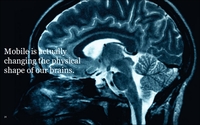
I never imagined I’d cover an industry keynote touching on the subjects of, among other things, 3D printing, drones, Big Data, and neuroplasticity -- but that’s pretty much what the
far-ranging and free-wheeling presentation of UPS Director of Social, Mobile and Digital Communications Rob Russell touched on during his keynote at OMMA Atlanta Thursday morning.
Best of all
was the way Russell framed the theme of the presentation: “Marketing in the Age of Now,” -- which, when you think about it, is a much better concept than “real-time” marketing.
In fact, Russell dumped on industry buzz terms like “RTM,” “Big Data,” etc., and simplified the value of all them with even older-school idea: “It’s all just
smarter marketing.”
advertisement
advertisement
In other words, delivering the right message to the right person at the right time. And who better to deliver that message than someone responsible for marketing a
service that, well, delivers the right things to the right people at the right time. But the most interesting parts of what he said, was how changes in data, technology and the consumer’s
mindset -- indeed, the physiology of their brains -- is changing the way UPS does exactly that.
Let’s get to the brain part first, because it suggests a whole new class of consumers is
evolving -- literally -- as the physiology of their brains changes due to media and technology.
Speaking about the new “mobile mindset” of consumers, Russell said UPS’
research indicates that it’s not just the way people think that is changing, but the way their brains process thought.
“Mobile is actually changing the physical shape of our
brains,” Russell said, describing the concept of “neuroplasticity,” or how our brains form new neural pathways that emphasize different brain processes depending on the kind of
information we receive.
Because of the complexity of the mobile information that taxi drivers must process, for example, Russell said research shows that cab drivers develop an enlarged
hippocampus region in their brains. He implied the same thing is happening with a group of mobile-centric consumers -- a group he labeled “shifted consumers” that currently represents
about 22% -- all of whom have “an overdeveloped hippocampus as a result of their mobile use.”
What do you do with that insight? You develop new products and services and methods of
communication that adapt to your evolving consumer population.
One of the examples, Russell cited, is the current state of UPS’ online tracking art, which enables consumers to track the
movement of their packages online with nearly pinpoint accuracy, zooming in to actual locations their packages reach along their route to you. Russell said the process isn’t exactly real-time
yet, and that UPS is still developing better and more refined geolocation “markers,” but he implied the process is approaching the point where you may someday literally be able to track
the movement of your packages in real-time along their route.
Meanwhile, UPS has also begun developing a marketplace around new technology that might one day obviate the need for a user to
track their packages along a route -- because there won’t be any route. Specifically, he was talking about the introduction of “3D printers” into UPS locations that are enabling
customers to dispense with the physical aspects of shipping altogether.
Like many of the industry buzz terms, Russell said he didn’t like the the term 3D printing, because he really
considers it “manufacturing on a small scale,” and more important, “just-in-time manufacturing.” The long-term implications of that are profound, he suggested, but “until
we can teleport plastic and things like that across the Internet,” he said people will still rely on physical shipping to get things to them.
On that note, he alluded to UPS’ plans
for delivery “drones,” but declined to elaborate other than to say it is conducting research and development and plans to incorporate them when they become economically and regulatorily
feasible to use.
He discussed the implications of other technologies -- including near-field wireless transmission -- that could also profoundly change the way physical goods get delivered,
but his main focus, he said was on delivering the best possible consumer experience, because if you do that right, your customers will “love” your brand, he said.